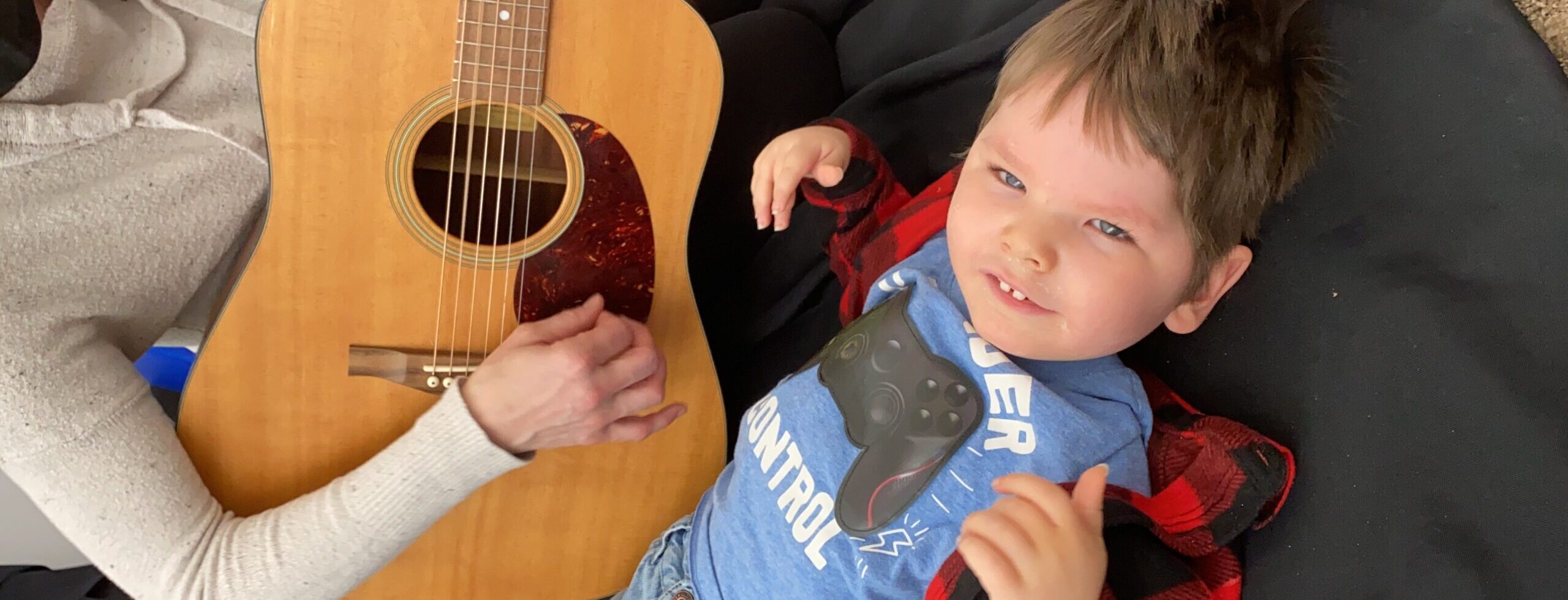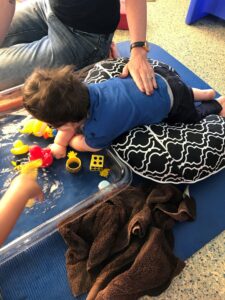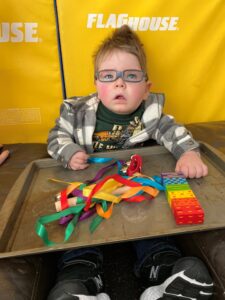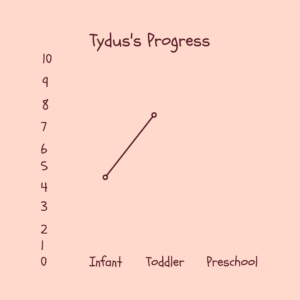
Case Study: Tydus
Hemimegalencephaly (HME)/Cortical Visual Impairment (CVI)
Tydus’s Story
as told by Malissa, Tydus’s mother

Tydus was born with Hemimegalencephaly (HME), a rare condition in which one side of the brain is larger and malformed. HME causes drug resistant, intractable seizures which Tydus was experiencing every 30 seconds. Brain surgery to disconnect the damaged half of the brain is one of the few treatments to stop or slow down seizures in kids with HME.
Hemispherectomy is where they go in and disconnect and remove half of the brain. Tydus had a left peri insular hemispherotomy, which is a type of hemipherectomy but they don’t remove the brain that is disconnected. It is left in the skull, as it decreases bleeding and risk for hydrocephalus.
Disconnecting causes numerous of deficits. One of those deficits is vision. When the occipital lobe of the brain is disconnected it takes out the peripheral vision on the opposite side. In Tydus’s case his left side was disconnected so he doesn’t have vision starting in the center to the right of each eye. He also has Cortical visual impairment (CVI).
The decision to have a surgeon disconnect half of your son’s brain and watching them walk him to the OR is absolutely heart wrenching, but we knew this was the only way Tydus would have a life.
Tydus was seizure free for just over 2 years and was off all of his seizure medications and then he started having seizures again. They were awful. They wouldn’t stop until I gave him his emergency medication. After several tests we found out that it looked like the left side of his brain was still connected. This isn’t uncommon with HME to have more than one surgery. The malformed brain is very hard to navigate and Tydus was very young. He underwent a revision of his hemispherotomy November 2020. Since then, he has been seizure free again!

Anchor Center has been an absolute life changer for Tydus. We started at Anchor when Tydus was six months old and he wouldn’t look at anything. We worked and worked and worked. I will never forget the first time he actually looked at my face. It was a dream come true, that look of, I love you mommy that will stay with me forever. Tydus is now three and his vision has come so far. He is making choices with pictures and is in the process of getting a communication device.
Anchor Center has helped Tydus understand what he is seeing and how to accommodate his visual deficits, like using his other senses and how to navigate his environment. I can’t imagine where we would be without Anchor. The staff is absolutely amazing. I have never walked into a building where I have felt more loved and where I know Tydus is loved. It is the most welcoming environment.
Anchor Center doesn’t just help these amazing kids, they also help parents. I have learned so much from them and they are always willing to help in navigating life, especially in the hardest moments. It’s truly a one-of-a-kind place. Our hearts will always be with Anchor and we will never be able to give them a gift big enough to thank them for the gifts they have given Tydus.
Tydus’s Diagnosis
as shared by Robert King, MD, Board Certified Ophthalmologist

Tydus was born with Hemimegalencephaly on the left side of his brain. This congenital malformation is associated with seizures which are difficult to treat with seizure medications.
Tydus had suffered significant developmental regression including his vision. This is unfortunately common with intractable seizures. Seizure control can lead to developmental progress, including vision.
Cortical visual impairment (CVI) is a reflection of brain connections that have failed to form congenitally or are interrupted. It is not surprising, then, that with the surgical interruption of these brain connections, that Tydus would have CVI. But he has no seizures.
His eye examination is significant for reduced vision and visual field loss. He has a complete right visual field loss. His visual acuity is measured at about 20/200 by his response to Teller Cards, a test for infants and young children. Additionally, Tydus has eye movement problems and optic nerve atrophy, which are no doubt side effects from his initial brain problem, the surgery or both. Also, he is near sighted and will benefit from wearing some glasses.

The challenge for Anchor Center teachers and his parents is to help Tydus develop alternate internal brain connections to bypass those that have been interrupted.
Neuroplasticity in the pediatric brain is amazing and we expect with appropriate intervention that vision improvement will occur. Long hours of practice will be necessary. Fortunately, by following his progress with Functional Vision Assessment administered by Anchor’s teachers specializing in vision impairment this can be optimized.
Tydus’s Program and Services
as shared by Callie Robinson, ECSE, TSVI, Perkins-Roman CVI Range© Endorsed
In May of 2019, Tydus visited Anchor Center for a functional visual evaluation. The CVI Range indicated that his visual skills were emerging but needed attention for development.

Despite his many medical issues Tydus scored 4.25 on his first assessment on a scale of 0-10. This means he was able to use some vision and begin to apply its functional use, such as looking at an object when he wants to play with it or looking into the face of someone caring for him.
Tydus’s mother and I reviewed his visual performances such as latency, the time it takes his brain to process visual presentations. We also looked at his ability to utilize hand-eye coordination. And his ability to visually comprehend new complex toys, a task difficult for children with CVI. With support from his home vision teacher, the Anchor Center Infant Toddler Program, and a careful progression of assessments, we have been able to target growth for his visual development.
Two years later, after consistently attending the toddler program, Tydus is performing higher level visual capabilities. His most recent CVI range score is 7-8.
capabilities. His most recent CVI range score is 7-8.
His mother describes that he can visually interpret 8-10 two-dimensional pictures and use them for communication purposes. This is exceptional because it demonstrates we have been able to support his access to his visual environment including pictures, and supported his access to communication. Tydus does not talk and is now able to rely on CVI-adapted pictures as one method for communicating his wants and needs.
Malissa also shared that at home Tydus is playing with toys that have complex buttons and functions. He is deliberate in his selection and with his vision he can specifically target where he wants his hands and fingers to go in order to activate it. These are the necessary foundational skills for what may come in the future for Tydus’s independence.
CVI Range Definition
The CVI Range is the only educational tool to assess the degree of impact on the visual functioning of a child with CVI. The functional vision of a child with CVI is measured on a continuum and functional vision can be improved with systematic and tailored interventions. The CVI Range scoring system uses a scale of 0-10, with 0 recording no detectable functional vision and a score of 10 reflecting functional vision of that of a typical child of the same age.
About Anchor Center and Our Professionals
The sole focus of Anchor Center is early intervention and education services to foster the full potential of children who are visually impaired or blind.
In addition to eye exams, functional vision assessments, programs and services, Anchor Center is a leader in research of early intervention of visually impaired or blind children. Currently, Anchor Center is collaborating with Rocky Mountain Hospital for Children and the Children’s Hospital Colorado to perform neonatal assessments to determine the risk of CVI, which is currently the leading cause of pediatric blindness. The results of the assessment, which is non-invasive, allows parents to address the risk through early intervention. A limited sampling of results include of the 70 babies screened, 52% have been identified as at risk for CVI.


Learn more about Anchor Center’s mission, programs and services, team, and how to support us. Anchor Center for Blind Children is a private non-profit organization funded by gifts from foundations and individuals.
